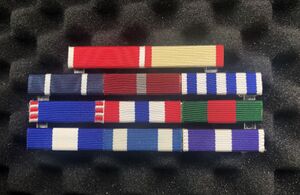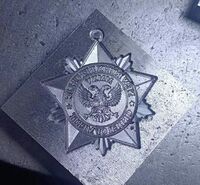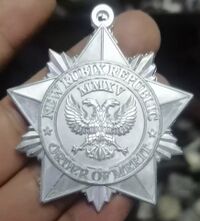Medal
A medal is a small, typically metal and hung from a ribbon, decoration awarded in recognition of achievement in various fields, outstanding performance or service. In a micronational context, medals are often awarded as a symbol of friendship between nations, to commemorate an important event or in receipt for services rendered to another micronation such as political engagement or civil service. A distinction can be made between the majority of medals which exist only digitally with a minority seeing minting and physical distribution. Due to the costly nature of production, the majority of micronational medals and awards are purely digital and ceremonious.
Designing

When designing a medal, inspiration is often taken from existing macronational orders, decorations, and medals. This is particularly apparent in digitalised designs where common design aspects can be observed due to the use of assets from sources such as Wikimedia Commons. Pre-existing assets are manipulated and customised to suit individual micronational needs with popular tools such as Inkscape. Designs may either be sketched first by an artist before being scanned and digitalised in computer program with common shapes and elements including stars, circles, crosses and wreaths.
The front of the medal is termed the 'obverse' and may contain state symbols, portraits and or other images along with an inscription. The back or 'reverse' of the medal is not always used due to increased production costs, an issue not relevant to digital medals, and may be left blank or contain a secondary design. It is common practise for medal designs to utilise the obverse for artistic renderings with the reverse utilised for inscribing details and other information. The rim of micronational medals is rarely utilised due to increased costs involved and is not commonly represented in digital medals.
Medals are often accompanied by a ribbon from which the medal is suspended if physical. The design of a medal ribbon may be chosen for reasons such as commercial availability, such as single or two colour ribbons, symbolism, or according to a design's colour scheme. The same design is typically used to represent that on a ribbon bar.
Production

Minting
To physically mint a medal, most micronations will contract either a workshop or company to produce their medals. There are several techniques used with medals typically casted from a mold created via methods such as computer numerical control (CNC). To cast the medal, molten metal is injected into the mold where it hardens before separation from the mold. The cost of a mold varies depending on factors such as medal size, design complexity, shape and number of sides.
Once cast, the medal may be polished, electroplated gold, silver or bronze and enamel added for colour. If requested as part of the order, it will then be inscribed with text via etching vs engraving, often by laser onto a dedicated blank area. In the case of micronations, micronationalists may sometimes use household items or printers to create medals at home.
Ribbons mounts and backing
Types of mounts
There are two styles of medal mounts commonly seen in micronational medals: rectangular and pentagonal ribbon mounts.
Rectangular ribbon mounts are the more common of the two and offered by practically all medal companies due to its prevalence[1]. There are two styles of rectangular ribbon medal mount: 'swing' and 'court'. In swing mounting, the medals are attached to the ribbon where they swing freely when worn on the recipient's chest, hence the name "swing-mounted." If a rectangular ribbon is chosen, companies will produce them as swing mounted as the default. Court-mounted medals are similar to swing-mounted except the medals themselves attached to a rigid backing board to prevent swing or independent movement. This can results in a neat and uniform appearance as the medals are secured to the backing in a fixed position. Few companies will offer this service when manufacturing and you have to approach a dedicated medal mounter or DIY.
Pentagonal ribbon mounts are less common and are most prominently seen employed in Eastern European or former Soviet-bloc countries. Medal manufacturers who offer this style of mount are often located in either China or Russia due its limited used in those approximate geographical areas. However, individual units can be obtained online and appropriated from existing or historical medals if a custom ribbon on a pentagonal mount cannot be sourced.

Types of backing
There are three common types of backing used: pinbacks, brooch pins and screwback fasteners.
Pinbacks consist of a metal pin or clasp attached to the back which is pushed the through the clothes' fabric and secured with a clasp or fastener on the other side. This method allows for comparative ease of manipulation due to its fast and easy detach nature. Brooch pins are metal bars featuring a safety-pin style attachment method and are fitted to the back of the medal's ribbon. Screwback fasteners are the least used and feature use small screws to attach the medal to clothing. This can causes visible holes in clothing once removed compared to the other two methods which are less damaging.
Distribution
Distribution differs between digital certificates and physical insignia. In the case of the former, the recipient is often presented with a receipt that acts as a certificate for the decoration. In the case of the awarding of insignia, they can either be mailed along with a certificate or awarded in person to the recipient. Common venues for awarding of physical medals are summits and meetings such as MicroCon where a section of the proceedings may be dedicated to the awarding of medals.
Controversies
When instituting a micronational medal, controversies can be caused if a macronational decoration is appropriated. This can be labelled as 'stolen valour' due to the nature of wearing unearned medals and is discouraged. Alternatively, the issue may be the specific decoration appropriated due to either historical association or symbolism represented such as the Iron Cross.
See also
Notes
- ↑ One source for rectangular ribbon mounts are school supply websites.



